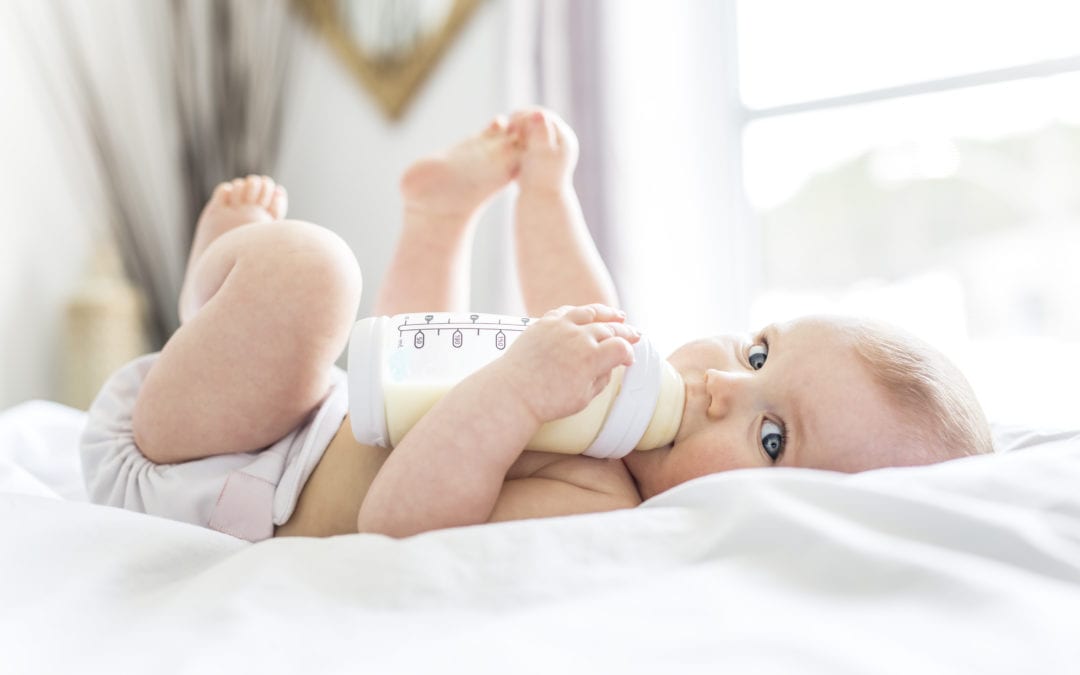
Read time: 3 minutes
TL;DR
- Experts agree that breastfeeding your little one for the first year of his or her life will provide the best nutritional start, but different challenges can make doing so difficult.
- If possible, experts recommend waiting until your little one is about two months old before introducing the bottle to ensure your milk supply is well-established and he or she has gained a steady amount of weight.
- Though they seem similar, breastfeeding and bottle feeding require different tongue and facial actions, which can make it difficult for a baby who has been exclusively breastfed to figure out how to make the switch.
- Combining breast and bottle feeding offers you the ability to go back to work or out for the evening while still providing your little one nutritious breast milk.
- Using a breast pump can help you to keep up or increase your milk supply or, if you are unable to do so, introducing formula can help to ensure that your little one is getting the nutrition he or she needs.
Experts agree that breastfeeding your little one for the first year of his or her life will provide them the best nutritional start. Though many moms aspire to exclusively breastfeed their babies during the first year, different challenges can make doing so difficult. Combining breast and bottle feeding offers many moms the best of both worlds.
Reasons for Combining Breast and Bottle Feeding
There are many different reasons to offer your little one a combination of the breast and bottle. These include:
- Providing your little one nutrition when you go back to work.
- Giving others the opportunity to feed your little one while you rest or are away for the evening.
- Beginning to breastfeed when your little one has been given bottles in the NICU due to premature birth.
- Allowing you to continue to provide breast milk for your baby during health complications or sudden life changes.
- Giving you the opportunity to compromise if breastfeeding is extremely challenging without giving up nursing completely.
Ideal Timeline for Bottle Introduction
During the first six to eight weeks of breastfeeding, your body will adjust to making the perfect amount of milk for your little one based on supply and demand. Because of this, experts don’t recommend introducing a bottle or a pacifier during this time. If possible, wait until your little one is about two months old before introducing the bottle. This will ensure your milk supply is well-established and he or she has gained a steady amount of weight.
Introducing the Bottle to Your Little One
Many moms who have been exclusively breastfeeding for the first couple of months of their little one’s life may be surprised when they try to give a bottle to their baby for the first time and find that he or she won’t take it. Though they seem similar, breastfeeding and bottle feeding require different tongue and facial actions, which can make it difficult for a baby who has been exclusively breastfed to figure out how to make the switch. Try these tips for helping your baby adjust to the bottle.
Try Different Bottles
There are a variety of different bottles and nipples on the market. It can take several tries before finding the perfect one for your little one. Don’t be afraid to experiment. Additionally, check out the flow rate of the nipple. If you have a fast letdown, a slow-drip nipple will quickly frustrate your baby.
Wait Until Your Little One is Satisfied
It may seem strange, but it can be helpful to breastfeed your little one for a few minutes before trying a bottle. When your little one is screaming to be fed, he or she won’t be as willing to try something new as when their belly is full.
Try a Different Position
Many moms hold their little one in a “cradle hold” against their chest during breastfeeding. If you try to hold your little one in a similar matter for bottle feeding, he or she may be confused. Try holding him or her in a different position.
Ask for Help
By this point, your little one probably equates your face, smell and touch with food. If you’ve been breastfeeding for months, your little one won’t understand why nursing isn’t happening when you try to provide a bottle. Asking someone else to feed your little one a bottle can make the transition easier.
Choosing to Introduce Formula
If you go back to work, you can continue to provide your little one breast milk while you are away by using a breast pump. Using a breast pump can help you to keep up or increase your milk supply, so you can continue to breastfeed your little one at home. If you aren’t able to do so, you may need to introduce formula to ensure that your little one is getting the nutrition he or she needs.
Because formula tastes different than breast milk, your baby will need to adjust. If your little one is rejecting formula, try combining breastmilk and formula in the same bottle.
It’s important to remember that if you are feeding your little one formula, your milk supply will most likely dip. Breastfeeding or pumping as much as possible when you and your little one are together will help you to maintain your supply.
Combining breast and bottle feeding offers you the ability to go back to work or out for the evening while still providing your little one nutritious breast milk. Only you know what’s best for your unique situation and baby. Offering both may give you the”break” you need in order to reach your breastfeeding goals as your little one grows this first year.


 Complete Our Simple Online Form
Complete Our Simple Online Form We’ll Handle All The Paperwork
We’ll Handle All The Paperwork Receive Your Free Ameda Pump
Receive Your Free Ameda Pump